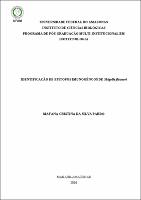| ???jsp.display-item.social.title??? |


|
Please use this identifier to cite or link to this item:
https://tede.ufam.edu.br/handle/tede/5968| ???metadata.dc.type???: | Dissertação |
| Title: | Identificação de epitopos imunogêncos de Shigella flexneri |
| ???metadata.dc.creator???: | Pardo, Mayana Cristina da Silva  |
| ???metadata.dc.contributor.advisor1???: | Nogueira, Patrícia Puccinelli Orlandi |
| ???metadata.dc.description.resumo???: | Shigella sp. é responsável por uma das principais causas de morbidade e mortalidade infantil, especialmente em países em desenvolvimento. A infecção por esta bactéria é conhecida como shigelose ou disenteria bacilar, uma diarreia inflamatória altamente contagiosa. A antibioticoterapia contra shigelose tem se tornado um desafio devido à crescente resistência aos antibióticos apresentada pelos isolados clínicos. Dessa maneira, a imunoprofilaxia direcionada para o desenvolvimento de vacinas tem se tornado prioridade pela Organização Mundial de Saúde no combate a shigelose. Considerando a necessidade de desenvolver novas estratégias de vacinação para o controle da shigelose, uma vez que ainda não existe uma vacina licenciada segura e eficaz, o presente trabalho objetivou identificar epitopos de célula B das proteínas OmpA e FimH de Shigella flexneri com potencial imunogênico, utilizando de análises in silico para a predição, além de avaliar a resposta humoral de camundongos imunizados com peptídeos sintéticos que imitam estes epitopos. Através do programa IEDB foram preditas 11 epitopos (5 para OmpA e 6 para FimH) e os peptídeos correspondentes foram sintetizados. A estrutura 3D desses antígenos também foi construída para facilitar a predição dos epitopos. Os peptídeos que reagiram ao antissoro anti-Shigella, foram selecionados para imunização de camundongos imunocompetentes. Os antissoros antipeptídeos P1 (controle positivo), P2, P3 e P4 foram produzidos e testados contra 13 isolados selvagens de Shigella flexneri, e apresentaram 92,3% (12/13) de reconhecimento pelo epitopo correspondente na proteína nativa presente nas cepas testadas. O epitopo mais imunodominante foi o P2 com resultado estatisticamente significativo (P<0,0422), quando o nível de reconhecimento de P2 foi comparado com P1, diferenças significativas também foram observadas (P<0,0155). O epitopo P4 foi o segundo epitopo imunodominante e está localizado em uma das alças na superfície da OmpA, enquanto o epitopo P2 que foi o mais imunodominante está localizado no domínio globular no espaço periplasmático. Entretanto, os anticorpos produzidos contra os peptídeos P2 e P4 foram capazes de reconhecer os isolados selvagens de S. flexneri, este resultado possibilita inferir que esses peptídeos possuem potencial para um candidato a vacina. |
| Abstract: | Shigella sp. is responsible for one of the leading causes of child morbidity and mortality, especially in developing countries. Infection by this bacterium is known as shigellosis or bacillary dysentery, a highly contagious inflammatory diarrhea. Antibiotic therapy against shigellosis has become a challenge due to the increasing resistance to antibiotics presented by clinical isolates. Thus, immunoprophylaxis directed towards the development of vaccines has become a priority for the World Health Organization in the fight against shigellosis. Considering the need to develop new vaccination strategies for the control of shigellosis and the absence of a licensed and safe vaccine, the present work proposed to identify B cell epitopes of the OmpA and FimH proteins of Shigella flexneri with immunogenic potential, using in silico analyzes for the prediction, besides evaluating the humoral response of mice immunized with synthetic peptides that mimic these epitopes. Through the IEDB program, 11 epitopes (5 for OmpA and 6 for FimH) were predicted and the corresponding peptides were synthesized. The 3D structure of these antigens was also constructed to facilitate the prediction of epitopes. Peptides that reacted to the anti-Shigella antiserum were selected for immunization of immunocompetent mice. The anti-peptide antisera P1 (positive control), P2, P3 and P4 were produced and tested against 13 wild isolates of Shigella flexneri, and showed 92.3% (12/13) of recognition by the corresponding epitope in the native protein present in the strains Tested. The most immunodominant epitope was P2 with a statistically significant result (P <0.0422), when the level of recognition of P2 was compared with P1, significant differences were also observed (P <0.0155). The P4 epitope was the second immunodominant epitope and is located in one of the loops on the surface of the OmpA, whereas the P2 epitope which was the most immunodominant is located in the globular domain in the periplasmic space. However, the antibodies produced against the P2 and P4 peptides were able to recognize wild isolates of S. flexneri, this result makes it possible to infer that these peptides have potential for a vaccine candidate. |
| Keywords: | Shigella flexneri Peptídeo sintético Estratégia vacinal Imunização |
| ???metadata.dc.subject.cnpq???: | CIÊNCIAS BIOLÓGICAS |
| Language: | por |
| ???metadata.dc.publisher.country???: | Brasil |
| ???metadata.dc.description.embargo???: | Período de Embargo: 15/12/2016 - 28/02/2021 |
| Publisher: | Universidade Federal do Amazonas |
| ???metadata.dc.publisher.initials???: | UFAM |
| ???metadata.dc.publisher.department???: | Instituto de Ciências Biológicas |
| ???metadata.dc.publisher.program???: | Programa de Pós-Graduação em Biotecnologia |
| Citation: | PARDO, Mayana Cristina da Silva. Identificação de epitopos imunogêncos de Shigella flexneri. 2016. 81 f. Dissertação (Mestrado em Biotecnologia) - Universidade Federal do Amazonas, Manaus, 2016. |
| ???metadata.dc.rights???: | Acesso Aberto |
| ???metadata.dc.rights.uri???: | http://creativecommons.org/licenses/by-nc-nd/4.0/ |
| URI: | http://tede.ufam.edu.br/handle/tede/5968 |
| Issue Date: | 18-Nov-2016 |
| Appears in Collections: | Mestrado em Biotecnologia |
Files in This Item:
| File | Description | Size | Format | |
|---|---|---|---|---|
| Dissertação_MayanaPardo_PPGBIOTEC.pdf | 4.81 MB | Adobe PDF |  Download/Open Preview |
This item is licensed under a Creative Commons License





